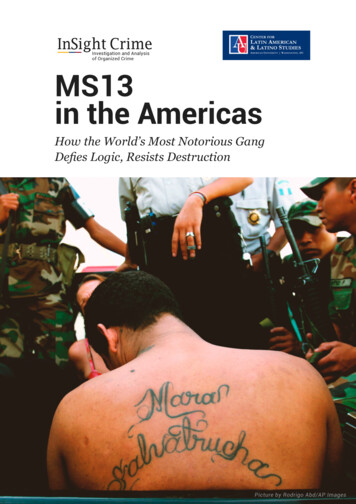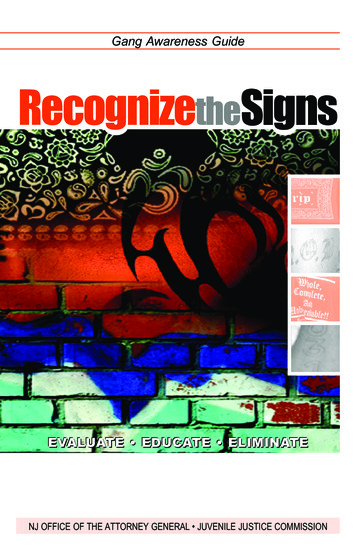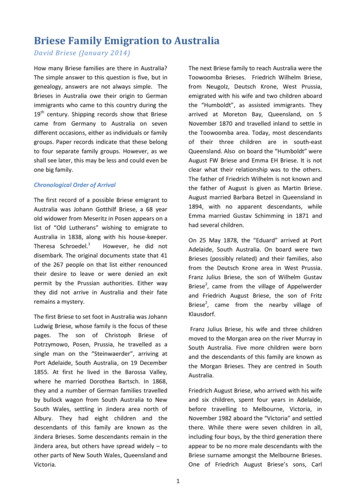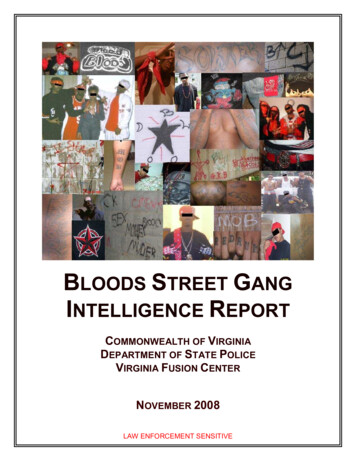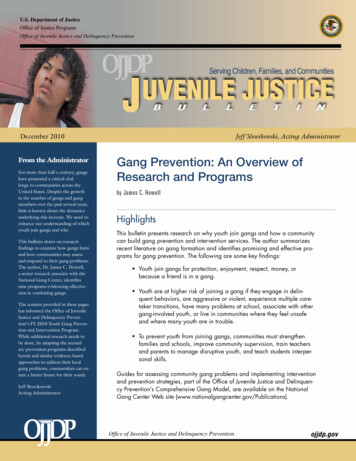
Transcription
U.S. Department of JusticeOffice of Justice ProgramsOffice of Juvenile Justice and Delinquency PreventionDecember 2010From the AdministratorFor more than half a century, gangshave presented a critical challenge to communities across theUnited States. Despite the growthin the number of gangs and gangmembers over the past several years,little is known about the dynamicsunderlying this increase. We need toenhance our understanding of whichyouth join gangs and why.This bulletin draws on researchfindings to examine how gangs formand how communities may assessand respond to their gang problems.The author, Dr. James C. Howell,a senior research associate with theNational Gang Center, identifiesnine programs evidencing effectiveness in combating gangs.The content provided in these pageshas informed the Office of JuvenileJustice and Delinquency Prevention’s FY 2010 Youth Gang Prevention and Intervention Program.While additional research needs tobe done, by adapting the secondary prevention programs describedherein and similar evidence-basedapproaches to address their localgang problems, communities can ensure a better future for their youth.Jeff SlowikowskiActing AdministratorJeff Slowikowski, Acting AdministratorGang Prevention: An Overview ofResearch and Programsby James C. HowellHighlightsThis bulletin presents research on why youth join gangs and how a communitycan build gang prevention and intervention services. The author summarizesrecent literature on gang formation and identifies promising and effective programs for gang prevention. The following are some key findings: Youth join gangs for protection, enjoyment, respect, money, orbecause a friend is in a gang. Youth are at higher risk of joining a gang if they engage in delinquent behaviors, are aggressive or violent, experience multiple caretaker transitions, have many problems at school, associate with othergang-involved youth, or live in communities where they feel unsafeand where many youth are in trouble. To prevent youth from joining gangs, communities must strengthenfamilies and schools, improve community supervision, train teachersand parents to manage disruptive youth, and teach students interpersonal skills.Guides for assessing community gang problems and implementing interventionand prevention strategies, part of the Office of Juvenile Justice and Delinquency Prevention’s Comprehensive Gang Model, are available on the NationalGang Center Web site (www.nationalgangcenter.gov/Publications).Office of Juvenile Justice and Delinquency Preventionojjdp.gov
DECEMBER 2010Gang Prevention: An Overview of Research and Programsby James C. HowellIntroductionSince the mid-20th century, gang violence in this countryhas become widespread—all 50 states and the District ofColumbia report gang problems, and reports have increased for 5 of the past 7 years. Despite the steady growthin the number and size of gangs across the United Statesand the criminal behavior and violence they spawn, littleis known about the dynamics that drive gangs and howto best combat their growth. For instance, no consensusexists on how gangs form, and few gang prevention programs have been rigorously evaluated. This bulletin presents a compilation of current research on gangs, includingdata on the state of gang problems in the United States today, why youth join gangs, the risk factors and attractionsthat increase youth’s propensity to join gangs, and howgangs form. The author examines how community members can begin to assess their gang problems and providenecessary enhancements to prevention and interventionactivities. The bulletin also describes a number of effective and promising programs that may help prevent youthdelinquency and gang violence.BackgroundTrends in Gang ActivityLocal youth gang problems in the United States increasedduring the 25-year period leading up to the mid-1990s(W.B. Miller, 2001). Whereas in the 1970s, only 19 statesreported youth gang problems, before the turn of the 21stcentury, all 50 states and the District of Columbia had acknowledged gang activity. Gang problems reported by lawenforcement in the National Youth Gang Survey (NYGS)1peaked in the mid-1990s, followed by a precipitous decline(Egley, Howell, and Major, 2004). An overall 15-percentincrease in youth gang problems reported in the NYGS2J uvenile J ustice B ulletinfrom 2002 to 2008 followed this decline, and all segmentsof the U.S. population reported increases in gang problems: suburban counties (22 percent), rural counties (16percent), smaller cities (15 percent), and larger cities (13percent) (Egley, Howell, and Moore, 2010). Only timewill show whether the recent increase in gang activity is alasting trend.Students report a similar trend in gang activity in schools.In the mid-1990s, 28 percent of a national sample ofstudents reported that gangs were present in their schools(Chandler et al., 1998). This statistic dropped to 17percent in 1999 and then began to increase to 23 percentin 2007, approaching the level reported a decade earlier(Dinkes et al., 2009).How Many Youth Join Gangs?According to the National Longitudinal Survey of Youth(a nationally representative sample of 9,000 adolescents),8 percent of the youth surveyed had belonged to a gangat some point between the ages of 12 and 17 (Snyderand Sickmund, 2006). A survey of nearly 6,000 eighthgraders conducted in 11 cities with known gang problemsfound that 9 percent were currently gang members and 17percent said they had belonged to a gang at some point intheir lives (Esbensen and Deschenes, 1998; Esbensen etal., 2010). However, this percentage varied from 4 to 15percent depending on location (see table 1). In a subsequent 15-city sample of adolescents (about 13 years old),almost 8 percent were gang members (Esbensen et al.,2008). Gang membership is even greater among representative samples of youth in high-risk areas of large cities,according to studies in Seattle, WA (15 percent); Denver,CO (17 percent); Pittsburgh, PA (24 percent); and Rochester, NY (32 percent) (Hill et al., 1999; Huizinga andLovegrove, 2009; Lahey et al., 1999; Thornberry, Krohn,et al., 2003).
Table 1. Gang Membership by Study LocationLocationPercentage of Youth Who AreGang MembersKansas City, MO10.1Las Cruces, NM11.0Milwaukee, WI15.4Omaha, NE11.4Orlando, FL9.6Philadelphia, PA7.7Phoenix, AZ12.6Pocatello, ID5.6Providence, RI6.0Torrance, CA6.3Will County, IL3.8Overall9.1Source: Esbensen et al., 2010, table 5.1. Used with permission.Demographic Characteristics ofGang MembersThe demographic characteristics of gang members varyby geographic location—mainly reflecting the demographic makeup of the youth population (Esbensen andLynskey, 2001).RaceAccording to the 2008 NYGS, half (50 percent) of allgang members are Hispanic/Latino, 32 percent areAfrican American/black, and 11 percent are Caucasian/white (National Gang Center, 2010). Studies where youthself-report gang membership show more equal proportions of racial/ethnic groups in samples. For example, ina 15-city sample, racial and ethnic proportions of youthreporting gang membership were quite similar for whites(7.3 percent), blacks (8.3 percent), and Hispanics (9.0percent), but larger (12.9 percent) for multiracial groups(Esbensen et al., 2008).GenderIn the 1997 National Longitudinal Survey of Youth, themale-to-female ratio of gang members was approximately2 to 1 (11 percent of males versus 6 percent of females)(Snyder and Sickmund, 2006). But a more recent 15-citysample that used self-reports classified 8.8 percent of boysand 7.8 percent of girls as current gang members(Esbensen et al., 2008).Starter Gangs and GangFormation TheoriesThis bulletin examines how youth move from delinquencyto joining gangs and how gangs form. Youth make aconscious choice to join a gang during adolescence, andmultiple personal and environmental factors influencethis choice.During adolescence, peer groups and social networksform, each of which can positively or negatively influence ayouth’s life. Rather than immediately joining serious, violent gangs, some youth become involved in less delinquentgroups, called “starter gangs.”Children and adolescents form starter gangs to introducethemselves to gang culture (i.e., distinctive attitudes,jargon, rituals, and symbols). In some areas, establishedgangs sometimes create cliques or sets composed ofyounger youth called “wannabes,” “juniors,” “pee wees,”and the like (Vigil, 1993). Where members of startergangs may engage in minor delinquent behaviors, gangmembers may be involved in serious and violent offenses.Researchers sometimes find it difficult to distinguish“gangs in embryo” from ordinary small groups of delinquents. A complicating factor is that very young gangsare extremely unstable. Adolescence is a time of changing peer relations and fleeting allegiances to both friends(Warr, 2002) and gangs (Curry, Decker, and Egley, 2002;Valdez, 2007).Shifting membership and an intermittent existence characterize many gangs, especially those with younger members.Because involvement in a variety of peer groups is common during adolescence, in many situations, gangs shouldbe viewed as social networks rather than as bounded“organizations” (Fleisher, 2006; Papachristos, 2006).Youth drift in and out of these groups, and even membersmay be unable to name all current members (Fleisher,1998). In a recent survey of middle school students innine cities, 25 percent of all gangs the students identified had been in existence for less than 1 year, and only10 percent were said to have existed for 11 years or more(Esbensen et al., 2008).The dynamics of gang formation are complex, and researchers and practitioners have studied them frompsychological, sociological, and criminological perspectives(Thrasher, 2000; Redl, 1945; Cloward and Ohlin, 1960;Davis, 1993; Esbensen, Huizinga, and Weiher, 1993;Cureton, 1999; Lahey et al., 1999; Thornberry, Krohn,et al., 2003; Tita and Ridgeway, 2007; Wood and Alleyne,2010; Vigil, 1993). A very popular assumption is that theyJ uvenile J ustice B ulletin3
In many large cities around the United States, seriousgangs have been established for years. In these circumstances, one might anticipate and yet find it difficult toprevent a youth from joining a gang. For instance, theChicano gangs in the southwestern United States thatformed in the early 1900s (Vigil, 1993) were populated bysecond-generation, “marginalized” children of extremelypoor, immigrant Mexican American families who found itdifficult to adjust socially and culturally to the Americanway of life (Vigil, 2008). Youth naturally joined the gangsaffiliated with their barrios (i.e., neighborhoods). Aftermore than a half-century of continuous presence in somebarrios, the Chicano gangs of Los Angeles have becomeinstitutionalized.grow out of conflicts among groups of young adolescents(Cloward and Ohlin, 1960; Cohen and Short, 1958) andconflicts with the law-abiding community (Short andStrodtbeck, 1974). Where gangs are not established, theymay form under extreme community conditions—particularly when youth are alienated from key socializing institutions, especially families and schools.A recent French study (Debarbieux and Baya, 2008) suggests that some gangs emerge from “difficult schools”that contain a small group of highly rebellious pupils. Thisgroup of students (4 to 5 percent of the student population) was responsible for most of the disorder and violencein 16 schools that were studied. In the most difficultschools, as many as 11 percent of all students were members of these gangs.In this theory, adolescents form gangs when they areexcluded from school for disciplinary reasons becauseschool is a place that provides support, education, andsocial networks for youth. This exclusion may help solidifythe group and lead toward gang formation. To becomea law-violating gang, adolescents involved must committo a criminal orientation (or willingness to use violence)(Decker and Van Winkle, 1996). Secondarily, the groupmust take on a criminal orientation as “a gang” that is setapart from other groups in the community (Klein, 1995).This group may be further solidified by conflict withschool authorities and the police.When gangs are already established, researchers observethat the gang-joining process is similar to the manner inwhich most people would go about joining an organization. A youth typically begins hanging out with gangmembers at age 12 or 13 (even younger in some instances)and joins the gang between ages 13 and 15. This processtypically takes 6 months to a year or two from the timeof initial association (Decker and Van Winkle, 1996;Esbensen and Huizinga, 1993; Huff, 1996, 1998).4J uvenile J ustice B ulletinAttractions to GangsFactors that contribute to a youth’s decision to join a gangfall into two categories: attractions and risk factors (Deckerand Van Winkle, 1996). This section discusses attractionsto gangs.A common public perception is that most youth arecoerced into joining a gang (Howell, 2007). Quite to thecontrary, most youth who join want to belong to a gang.Gangs are often at the center of appealing social action—parties, hanging out, music, drugs, and opportunities tosocialize with members of the opposite sex. The gang maybe appealing because it meets a youth’s social needs.Youth reported the following reasons for joining a gang,in the order of descending importance (Esbensen,Deschenes, and Winfree, 1999): For protection. For fun. For respect. For money. Because a friend was in the gang.These are the typical gang attractions that youth acknowledge. Of these reasons, youth most commonly join gangsfor the safety they believe the gang provides (Decker andCurry, 2000; Decker and Van Winkle, 1996; Peterson,Taylor, and Esbensen, 2004; Thornberry, Krohn, et al.,2003). Another important influence is family members(especially siblings or cousins) who already are part ofthe gang (Curry, Decker, and Egley, 2002; Thornberry,Krohn, et al., 2003), especially for Mexican Americanyouth (Valdez, 2007). Youth also occasionally cite economic reasons, such as selling drugs or making money,for joining a gang (Decker and Van Winkle, 1996).
EthnicityIn many large cities, the attraction of gangs is in part abyproduct of population migration (Adamson, 2000;Howell and Moore, 2010; Vigil, 2002, 2008). DiegoVigil suggests that this may be a result of the difficultiesimmigrant youth may experience in dealing with life ina new culture, combined with inadequate parenting andschooling. The language, cultural, and economic barriersthey face “[leave] them with few options or resources tobetter their lives. Often, they seek a place where they arenot marginalized—and find it in the streets” (Vigil, 2002,p. 7). Gang life also meets these youth’s need for family andcommunity by filling the void that inadequate family careand schooling leave.Popular CultureApart from personal reasons for joining a gang, media presentations make gangs seem very appealing (Miller, 1992).The “hip” lifestyle and sensational portrayals of gangs andtheir members have a significant influence, particularly onmore susceptible youth, for reasons that Walter B. Miller(2001, p. 46) aptly explains:In the 1950’s, the musical drama West Side Storyportrayed gang life as seen through the eyes ofadult middle-class writers and presented themes ofhonor, romantic love, and mild rebellion consistent with the values and perspectives of thesewriters. In the 1990’s, the substance of gang lifewas communicated to national audiences througha new medium known as gangsta rap. For the firsttime, this lifestyle was portrayed by youthful insiders, not adult outsiders. The character and valuesof gang life described by the rappers differed radically from the images of West Side Story. Languagewas rough and insistently obscene; women wereprostitutes (“bitches,” “ho’s,” and “sluts”) tobe used, beaten, and thrown away; and extremeviolence and cruelty, the gang lifestyle, and craziness or insanity were glorified. Among the rappers’ targets of hatred, scorn, and murder threatswere police, especially black police (referred to as“house slaves” and “field hands”); other races andethnic groups; society as a whole; and members ofrival gangs . . . Gangsta rap strengthened the desire of youth to become part of a gang subculturethat was portrayed by the rappers as a glamorousand rewarding lifestyle.experiment with gang life” (Klein, 2002, p. 246). The diffusion of street gang culture in modern-day movies, music,and clothing merchandizing has served to intertwine gangculture with the general youth subculture.Researchers have shown how youth experiment with ganglife in several studies. In a St. Louis, MO, study of middleschool students, more than half of the surveyed youth whohad never been in a gang said that they had engaged in atleast one kind of gang involvement (Curry, Decker, andEgley, 2002). More than one-third of the youth who hadnot been in gangs had gang members as friends, nearlyone-third had worn gang colors, nearly one-quarter hadhung out with gang members, and one-fifth had flashedgang signs. In a study of Florida middle school students(Eitle, Gunkel, and Gundy, 2004), only 5 percent of thesample of nearly 10,000 students reported having joineda gang, but half of the youth who had not joined hadengaged in 1 or more behaviors that suggested “gangorientations” (Eitle, Gunkel, and Gundy, 2004, p. 101)—they had flashed gang signs, worn gang colors on purpose,drunk alcohol or gotten high with gang members, or hungout with gang members.Friendships and Romantic RelationshipsMany female adolescents are attracted to gangs becausetheir friends or boyfriends have joined. One book lookedat girls in San Antonio, TX, who hung out with male gangmembers (Valdez, 2007). Although they were not recognized as gang members, these girls were “distinctly integrated” into the male gangs (Valdez, 2007, p. 87). Theybegan hanging out with the gang in childhood, just beforeage 12, and at the time of the study, 40 percent reportedhaving a boyfriend in a gang and 80 percent said they hada good friend in a male gang. Gang associations led tothe girls’ involvement in delinquent and criminal activities, including holding drugs (55 percent), selling drugsIncreased media popularization of gang culture has led tothe point that now, “most young people in America recognize the look, the walk, and the talk of gang members.Many mimic it in part or in whole. Many try it out as apersonal style. Play groups, break-dancing groups,taggers (i.e., graffiti artists), and school peer groupsJ uvenile J ustice B ulletin5
Individual Risk Factors(31 percent), and holding weapons (27 percent) (Valdez,2007). Hence, program development and service deliveryshould not ignore gang associates.Risk Factors for Joining GangsThis section examines risk factors—forces that push youthtoward gangs or increase the likelihood that affected youthwill join a gang.2 Researchers cannot predict whether aparticular individual will join a gang. Rather, researchshows that individuals who possess certain risk factors havean elevated chance of joining a gang.The Office of Juvenile Justice and Delinquency Prevention’s(OJJDP’s) Strategic Planning Tool (www.nationalgangcenter.gov/SPT) includes a list of risk factors that predict juveniledelinquency and gang membership because virtually allyouth who join a gang previously were involved in delinquent acts (Hill et al., 1999; Esbensen and Huizinga,1993; Thornberry, Krohn, et al., 2003). To compile thislist, the National Gang Center (NGC) analyzed a numberof studies of children and adolescents who were surveyedover several years. The studies examined risk factors forserious and violent delinquency or gang involvement(Loeber and Farrington, 1998, 2001; Howell and Egley,2005). The risk factors discussed in the Strategic PlanningTool also draw heavily on the two more comprehensive reviews on this topic (Loeber and Farrington, 1998, 2001).3The following discussion of risk factors for gang involvement summarizes longitudinal research shown in theOJJDP Strategic Planning Tool. Other kinds of studies,particularly ethnographic research that provides insightsinto how particular risk factors may operate, supplementthis discussion. The discussion organizes these risk factorsinto five domains: individual, family, school, peer group,and community, based on a systematic literature review(Howell and Egley, 2005).A number of personal risk factors make children morelikely to join gangs.Antisocial behavior. Children whose antisocial behaviorconsistently worsens are most likely to join gangs. Thesebehaviors include early involvement in delinquency, aggression, violence (without a weapon), alcohol or druguse, early dating, and precocious sexual activity (Craig etal., 2002; Lahey et al., 1999; Thornberry, Krohn, et al.,2003). In adolescence, other forms of violence emerge—such as attacking someone with a weapon—that may alsopredict joining a gang (Thornberry, Krohn, et al., 2003).Alcohol and drug use. Alcohol and drug use also predictjoining a gang (Huizinga and Lovegrove, 2009). Thesetwo early problem behaviors increase the likelihood oflater gang involvement, particularly when alcohol or druguse is extensive and involves marijuana (Hill et al., 1999;Thornberry, Krohn, et al., 2003).Mental health problems. Although little research hasbeen done on the subject, evidence suggests that certainmental health problems in young people increase their riskof joining a gang. These problems include conduct disorders, externalizing behaviors, hyperactivity, and depression(Howell and Egley, 2005). Davis and Flannery (2001)noted that gang members in juvenile corrections facilities“often are admitted with histories of physical and sexualabuse, substance abuse, psychiatric disturbances, posttraumatic stress disorder, cognitive deficits, poor self-esteem,and other problems” (Davis and Flannery, 2001, p. 37).Victimization. Children who are victims of abuse orneglect are more likely to join gangs (Fleisher, 1998; J.A.Miller, 2001; Thornberry, Krohn, et al., 2003). Forms ofviolent victimization outside the home, such as assaults,also increase youth’s risk of joining a gang (Peterson,Taylor, and Esbensen, 2004; Taylor, 2008; Taylor et al.,2007, 2008).Negative life events. Youth—particularly boys—whoexperience negative life events also are more likely to joingangs (Thornberry, Krohn, et al., 2003). These events6J uvenile J ustice B ulletin
“Students who feel vulnerable at schoolmay seek protection in the gang.”include failing a course at school, being suspended fromschool, breaking up with a boyfriend/girlfriend, having afight or problem with a friend, and the death of someoneclose.Family Risk FactorsFrom birth, parents are critical in promoting child development (Loeber and Farrington, 2001). Early on, weaknesses in family structure (e.g., a single-parent household,multiple family transitions, or caretaker changes), poverty,and general financial stress are potent risk factors. Theseadversities diminish effective parental supervision and control and disturb the development of strong family bonds(Howell and Egley, 2005). Other factors compromiseparents’ capacities to encourage their children’s growthand development, including lack of education, attitudesthat condone violence inside and outside the home, andchild abuse or neglect (Howell and Egley, 2005). If familymembers are involved in gangs or criminal behavior, thiscan lead youth to join gangs and alienate them from ahealthy family life (Moore, 1991; Vigil, 1988).School Risk FactorsMost studies that examine school-related risk factors forjuvenile delinquency and gang membership have only examined a student’s level of academic achievement—whichis a strong predictor for gang membership. For example,poor school performance on math tests predicts male gangmembership (Thornberry, Krohn, et al., 2003). However, studies of school experiences now include measuresof “school climate” (Gottfredson et al., 2005) and student “connectedness” to schools (Resnick, Ireland, andBorowsky, 2004). Future gang members perform poorlyin elementary school and generally have a low degree ofcommitment to and involvement in school (Hill et al.,1999; Le Blanc and Lanctot, 1998) and weak attachmentto teachers (Thornberry, Krohn, et al., 2003).A French study (discussed on p. 4) identified current orfuture gang members among a small subgroup of students“who consider that everything is wrong with school andthat teachers are awful, who commit aggression moreoften than others, who are punished repeatedly and morefrequently than the others, and who have developed afeeling of hatred and rejection of everything that represents order” (Debarbieux and Baya, 2008, p. 214). Thesestudents most often attended the most difficult schools—schools characterized by greater levels of student victimization, self-reported violence, poor student-teacher relations,and systems of punishment that pupils did not accept well(Debarbieux and Baya, 2008, p. 212). Other researchsuggests that poorly functioning schools with high levelsof student and teacher victimization, large student-teacherratios, poor academic quality, poor school climates, andhigh rates of social sanctions (e.g., suspensions, expulsions,and referrals to juvenile court) hold a greater percentageof students who form and join gangs (Bernburg, Krohn,and Rivera, 2006; Debarbieux and Baya, 2008; Gottfredson and Gottfredson, 2001; Morrison and Skiba, 2001;Thornberry, Lizotte, et al., 2003; Weisel and Howell,2007). For example, nearly 8 of 10 gang-involved youthreferred to juvenile court in Durham, NC, had been suspended, truant, expelled, or otherwise disconnected fromschool (Weisel and Howell, 2007).In addition, negative conditions in difficult schools canincrease future delinquency (Hemphill et al., 2006; Huizinga and Henry, 2008; Kaplan and Damphouse, 1997),which also increases gang membership (Esbensen andHuizinga, 1993; Hill et al., 1999; Thornberry, Lizotte,et al., 2003).Feeling unsafe at school may also predict gang involvement (Gottfredson and Gottfredson, 2001; Vigil, 1993).Students who feel vulnerable at school may seek protection in the gang.Peer Group Risk FactorsOne of the strongest risk factors for gang membership isassociating with peers who engage in delinquency (Thornberry, Lizotte, et al., 2003). Aggressive and antisocialyouth begin to affiliate with one another in childhood, andthis pattern of aggressive friendships continues throughadolescence (Kupersmidt, Coie, and Howell, 2003; Warr,J uvenile J ustice B ulletin7
2002). Association with aggressive peers during childhoodand early adolescence is a strong predictor of joining a gang(Craig et al., 2002; Lahey et al., 1999), as is the experienceof having been rejected by peers (Huizinga and Lovegrove,2009).Community Risk FactorsAs children grow older and venture out from their families, community conditions become a greater influence.Gangs tend to cluster in high-crime and economicallydisadvantaged neighborhoods (Pyrooz, Fox, and Decker,2010; Thornberry, Krohn, et al., 2003; Valdez, 2007;Vigil, 1988). When gangs cluster in these neighborhoods,a number of negative conditions may arise, including(Howell and Egley, 2005): A greater level of criminal activity. A large number of neighborhood youth involved inillegal behaviors. Widespread availability and use of firearms and drugs. A small level of neighborhood attachment (i.e., positivefeelings of belonging and being valued).Unfortunately, in most distressed neighborhoods, schools,churches, and other community agencies and institutionsdo not provide adequate gang prevention and interventionservices (Thrasher, 2000). In the worst conditions, “collective efficacy”4 may be lacking (Morenoff, Sampson, andRaudenbush, 2001).Risk Factors: A SummaryChildren who are on a trajectory of worsening antisocialbehavior, including child delinquency, are more likely tojoin gangs during adolescence. Gang members tend tohave more risk factors than other serious and violentoffenders, and these factors can often be placed inmultiple developmental domains. In essence, one canthink of gang entry as the next developmental step in escalating delinquent behavior (Craig et al., 2002; Esbensenand Huizinga, 1993). Gang membership is not a productof several specific risk factors, but the result of the accumulation of many varied kinds of risk factors (Krohn andThornberry, 2008).Risk factors in each of the five developmental domainsoperate collectively to increase youth’s propensity to joingangs. Youth who initiate delinquent behaviors and exhibitaggression or violence at an early age (individual); experience multiple caretaker transitions (family); have numerous school-related problems (school); associate with otheraggressive, gang-involved delinquents (peers); and live incommunities where they feel unsafe and where manyyouth are in trouble (community) are at a higher risk ofjoining a gang.How Risk Factors WorkRisk factors predict increased risk for developing a problemor disorder. They also help determine the pathways thatsome children and adolescents take when they becomeinvolved in juvenile delinquency and gangs. However, thepresence of specific risk factors does not guarantee thedevelopment of specific problem behaviors.Risk factors function in a cumulative fashion—the largerthe number of risk factors, the greater the likelihood ofa negative outcome, such as joining a gang. In a Seattlestudy, children younger than age 12 who experienced 7of 19 measured risk factors were 13 times more likely tojoin a gang than children with only 1 risk factor or no riskfactors (Hill et al., 1999; Hill, Lui, and Hawkins, 2001).The likelihood of joining a gang is even greater when youthexperience multiple risk factors in multiple domains. Forexample, Rochester researchers (Thornberry, Krohn, et al.,2003) measured seven risk-factor domains—neig
terize many gangs, especially those with younger members. Because involvement in a variety of peer groups is com-mon during adolescence, in many situations, gangs should be viewed as social networks rather than as bounded “organizations” (Fleisher, 2006; Papachristos, 2006).


